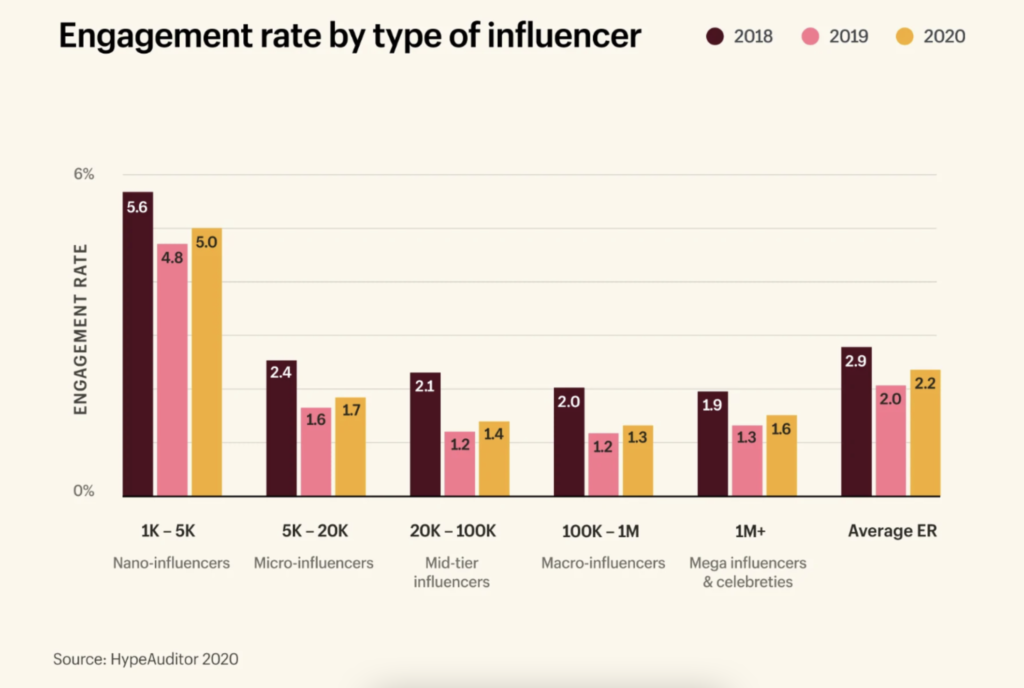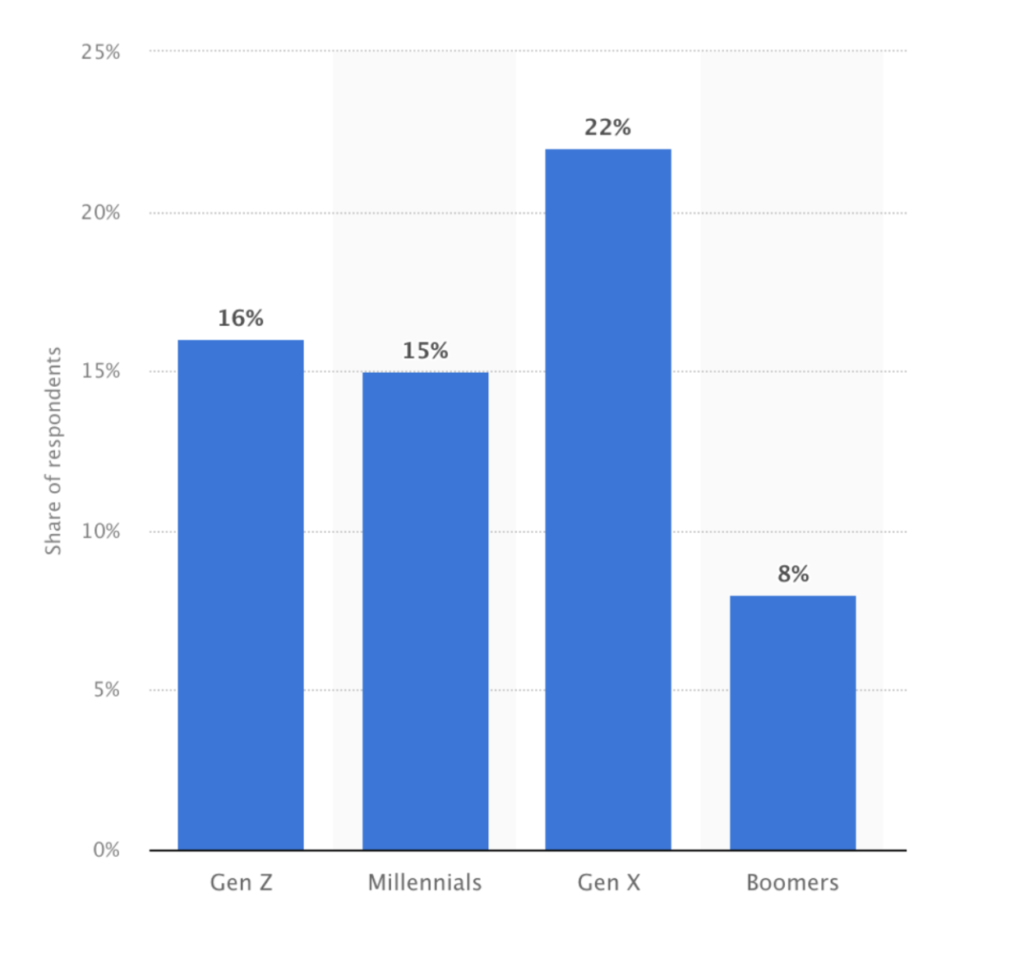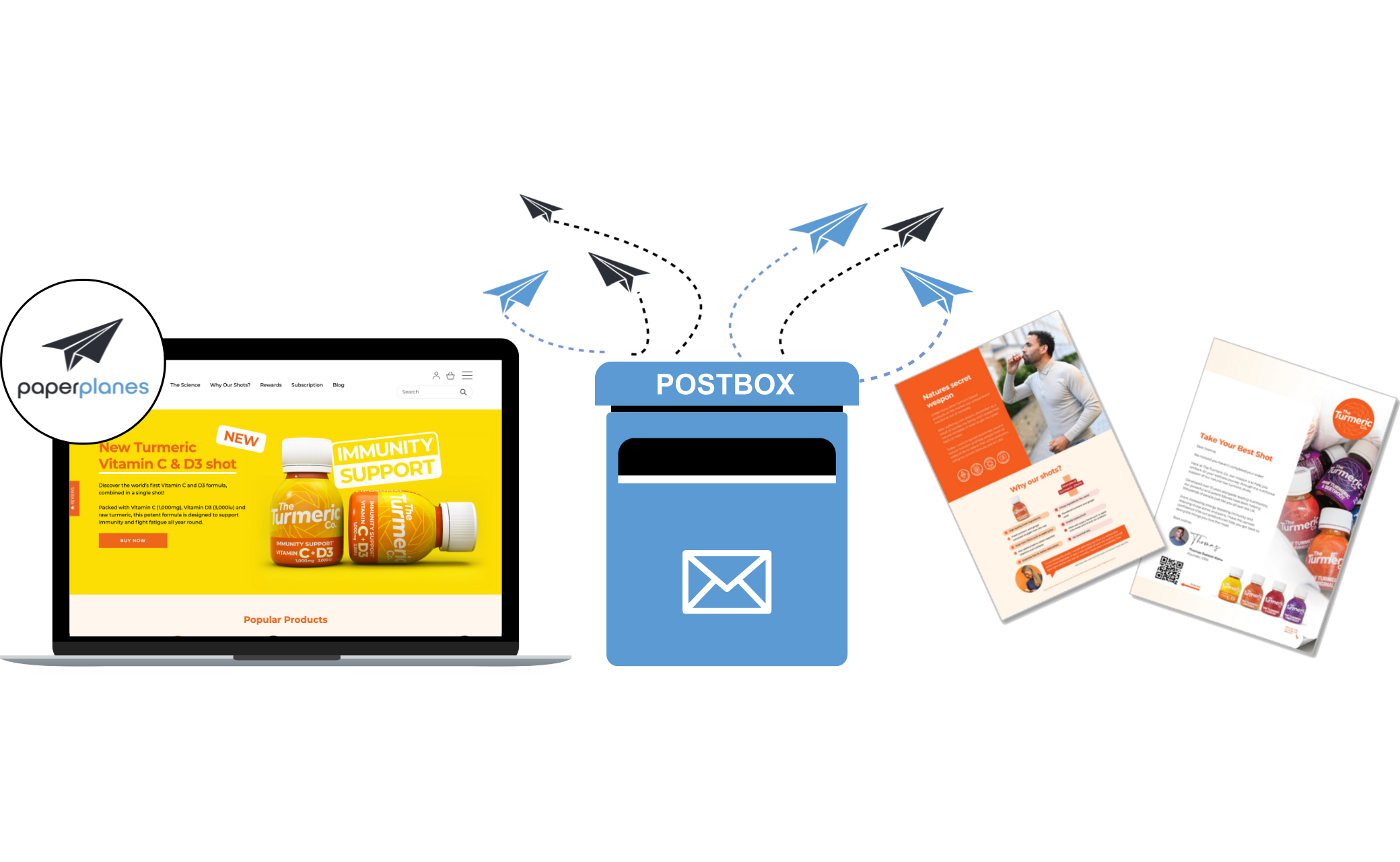Influencer Marketing and Programmatic Direct Mail
Influencer Marketing
Modern Day marketing has been transformed by the rise of social media platforms such as Instagram,Facebook, Linkedin, Twitter and TikTok. Many individuals are now growing their own fan bases and becoming their own brands, in many ways, creating microeconomics that is largely scalable. Established influencers can provide an impressive $6.50 per every dollar invested in marketing with them (Tomson,2022) - making it the fastest-growing online marketing tactic to date (although not as strong as some of the ROI we see on Paperplanes campaigns ).

The Influencer Marketing Hub has calculated that roughly $ 13.8 Billion will have been spent on influencer marketing in 2021, demonstrating that there is a success and attraction for this type of marketing, with a clear benefit of return from the initial investment. Companies who are using Influencer marketing tend to favour Instagram as the choice platform with 68% of companies posting their influencer marketing there. Instagram is a platform with over 1.1 Billion active users and 90% of those users follow a brand that is advertising on that platform. This is typical because most of the influencer's network is following them on that respective platform.
But is instagram, or any social media platform for that matter, the best way to sell to consumers?
In short, No. Instagram has an average of 1.08% conversion rate, which is just barely above the 1% email conversion rate average (Statista, 2022). On Top of this, you will likely have to pay both the influencer and the digital platform, whilst competing for traffic and bidding. Utilising a celebrity influencer as an ambassador/figure representation for your product is often not enough. Companies have to be smart in the way they engage with their consumers. Using influencer marketing with Paperplanes intelligent direct mail has proved to have up to 30% conversion rates for online stores.
This might lead you to believe that influencer marketing could be a great potential opportunity for your business before that consider the following questions:
What exactly are influencers and what are the roadblocks?
How can Programmatic Direct Mail optimise your campaign results?
Which demographics do Influencer marketing have the strongest effects on?
Influencers can be poorly defined. Each platform has its own measurement which is considered professional, whereas influencers charge you more. Kim Kardashian is paid an average of $850,000 per Instagram post to over 200 million followers, but with a rippling effect due to her expanded network and net worth of $1.8 Billion (ManyofMany,2022).
More commonly, influencers of today are defined by segments of a few thousand up to >1M.

Source (https://www.shopify.com/blog/influencer-marketing-statistics)
Over the years, the smaller ‘micro-influencers have grown to have higher engagement and response thanks to the younger generations' ability to share content for free via online content.
So what are the main issues with these types of micro-influencers for marketing?
- Demand
-
-
- As is the case with all trends they attract demand to a certain person, service, idea or product and supply is scarce. This logic can be applied to influencers who might have busier periods of the year or might be going through a boom in popularity thus increasing their demand and possibly price.
-
- Style of Content
-
-
- The content amount will change the price an Influencer would charge. If an Influencer is asked to create a large number of posts or a large amount of high-effort content it’s going to cost more.
-
- Follower engagement
-
-
- Some influencers might have a large audience but only engage a small percentage in the advertising they do. This will lower their value as a marketing pipeline hence lowering the price they will receive for their assistance.
-
- Platform
-
- Content creators and influencers have their own personal preferences and social media platforms that they use and are willing to advertise on. Tying it in with the style of content certain platforms thrive on shorter or longer content which might affect the willingness to collaborate with a firm.
- Distribution
- As aforementioned, using an influencer in aid to your marketing strategy is a clear risk-free investment. However, the channels in which your marketing is promoted may be ineffective. A physical direct mail channel could be a solution, where content is always read and almost always actioned upon. Especially when the right people are targeted by an influencer they love.
- As aforementioned, using an influencer in aid to your marketing strategy is a clear risk-free investment. However, the channels in which your marketing is promoted may be ineffective. A physical direct mail channel could be a solution, where content is always read and almost always actioned upon. Especially when the right people are targeted by an influencer they love.
Programmatic Direct mail
Direct mail marketing drives strong performance and high response rates compared to other marketing channels while not being as costly as influencer marketing on digital channels. Competition, traffic and timing are no longer an issue, and using programmatic data tracking such as Paperplanes innovative technology allows you to identify s, the right people who follow a particular influencer in their homes; multiplying the effectiveness of the response.
Notably, in 2021 Direct mail marketing had a 9% response rate, up to an astounding 30% utilising Paperplanes programmatic capabilities; tracking customer web data for targeting only the right people at the right time. Paperplanes can achieve the same if not better results as traditional bulk mail marketing with up to 78% less send volume.
In regards to variable costs, direct mail marketing and specifically programmatic direct mail marketing are much more stable in their pricing. Without there being factors such as platform and content length Direct mail comes out to be a more affordable to consistent channel of marketing.
When taking website data and integrating it in an algorithm to produce personalised and targeted direct mail pieces, the results attained can be more than tenfold that of classic direct mail. Paperplanes demonstrated that Programmatic direct mail can respectively achieve 30% conversion rates, ROAS as high as £ 11-1 and uplift on sales as high as 50%.
Demographics
Different marketing channels undeniably will attract different demographics from their efforts. Direct mail marketing has a strong response rate with both younger and older generations. Influencer marketing is not much different in the sense that it has a clear demographic that it can attract to a business.
Gen Z
Statistics would argue that Gen-Z has the strongest response to Influencer marketing despite not holding as much of the market compared to Gen-X and Baby Boomers. Gen Z has the highest usage rates on media such as Instagram and TikTok with 71% and 58% of the generation using those media platforms. But also 82% more likely to read and act upon direct mail content addressed to them.
This generation follows social media trends and influencers much more closely than other generations leading to Influencers with forward-thinking mindsets being more successful at marketing to this generation. Gen-Z will follow Gen-Z leading to a snowball effect with members of Gen-Z wanting to find out what their peers are interested in and who they are following.
Millennials & Gen-X
These older generations tend not to react to similar styles of Influencer marketing as Gen-Z. Whilst no Generation is as active on social media as Gen-Z overall, these older generations do respond better on platforms such as LinkedIn and Facebook.
Whilst the younger generation has a knack for following trends more closely and being swayed easier, these two generations have great response rates to nostalgic marketing and authentic personalities when it comes to Influencers.
To better demand the attention of these two generations it would be optimal to utilise influencers who this generation would be more familiar with. Influencers who might invoke nostalgic feelings or influencers who are more authentic in the way they present themselves and the content that they are marketing. This generation also is quite susceptible to physical mail content, with up to 72% of millennials taking action upon or at least reading the content.
If you’d like to learn how you can integrate influencer marketing in a programmatic direct mail campaign to improve your current strategy, get in touch with us below for a chat with our experts.
Sources
https://influencermarketinghub.com/influencer-rates/
https://www.businessofapps.com/marketplace/influencer-marketing/research/influencer-marketing-costs/
https://www.mavrck.co/influencer-marketing-by-demographic-stc-deep-dive/
Psychology behind "Free"
What is the power of Free Offers?
Free sample, Free trial, Free first month subscription, buy 1 get 1 free, free for the first 100 to sign up - how many of these ‘free’ offers do you see on a daily basis?
Quite a few right? ‘which clearly demonstrates the adoption of freemium marketing and sales strategies are highly efficient at doing their job in swaying purchasing behaviour.
Free offers and free items have been used historically for centuries across all industries. Grocery retailers might offer a free food sample, music streaming services might offer a free stripped-down product and subscriptions might offer a month's trial if you sign up for a longer period.
On paper, this might seem wasteful or more so an avoidable cost for firms. However, there could be a number of reasons why companies would want to offer free trials:
- Dissatisfaction is nullified
- Builds consumer spending potential
- Increases perceived value for money
- Creates confidence in the brand and in the consumer's decision
The risk of dissatisfaction is nullified
The right side of the human brain, responsible for more rationale thought, thinks in logical ways, and from an economist's point of view, the opportunity cost of taking something for free is very appealing, especially when the offer is for something which holds high value and/or addresses key wants and needs. This could eliminate the risk of dissatisfaction for the consumer if the product or service they are receiving hasn’t cost them any money, as the perceived value is much higher.
A great example of dissatisfaction being eliminated is offering free add-ons for meals. The consumer who purchases the meal isn’t expecting a freebee so when they are served their free dessert perhaps as a birthday surprise they feel warmer to the brand(assuming they enjoyed their meal). As an added value component the consumer might then feel obligated to return to the establishment simply due to reciprocity.
Reciprocity is also going to have an effect on the consumer emotionally. Having just received something for free (or having something done for you for free) makes customers instinctively feel obligated to do something in return, such as going on to subscribe to the service they were offered or purchasing the product which they just sampled.

Source (https://chartmogul.com/blog/make-trial-to-paid-conversion-rates-meaningful-with-cohorts/)
Consumer spending increases
When offering discounts, coupons or free deals a consumer's purchasing power will increase in a way, as they will likely be willing to spend more money over a longer period l. In some cases, consumers justify making more purchases due to having received something for free, flexing their purchasing power and getting the best deal for themselves.
With consumers purchasing more stock during discount periods and free offer periods, the power of free demonstrates how it can boost sales and revenue.
Cash points or rewards
Another valid strategy for implementing free offers would be doing reward/cash rewards that come with making purchases.
Local coffee shops and breweries may give you a small card that gets stamped with every drink you purchase. Eventually, after a certain amount of coffee you might be given one for free for being a loyal customer.
This incentive can really help when competing with local competitors. Consumers get drawn into making repeat purchases and returning to the business that is offering them a free drink after X amount of purchases.
In most supermarkets owning a loyalty or rewards card can have the same effect. With a membership card to the supermarket, you might be offered discounts on certain products or cash points. With cash point rewards consumers will eventually be getting products for free as they must have already spent some money at the supermarket.
This psychological tactic of getting consumers to make several purchases from the business before being given something for free builds on the reciprocity principle. As much as humans are instinctively drawn to show reciprocity for receiving something for free they will also feel the need to be given something in return for their loyalty. This is exactly where cash points and rewards become effective.
Why bother trying everything for free?
Indeed that is the final question to ask at this point. If everyone offers something for free, why bother trying it all? Most free offers come with a purchase or an engagement catch or may be difficult to opt out of. Some don't and offer an easy opt-out (if you remember to cancel the subscription or your card is charged following the trial).
Before considerable thought is put into a freemium or free giveaway strategy the overall product offering and relevancy of creative should first be scrutinized. Paperplanes have run extensive tests that outline that in some instances no extra incentive at all (let alone free) is required to trigger a purchase. Simply getting the product combinations right on your tangible media can drive greater conversion and strong er basket value!
Paperplanes programmatic direct mail utilises website customer data and activity to automatically create personalised promotional content which is sent to the individual's homes shortly after their digital interaction. Mixing the best of digital data use whilst cutting through competitive online space and bidding costs and getting almost instantly read by the recipient.
Paperplanes programmatic campaigns work best with freemium or % discounts where campaign results show staggering 30% conversion rates, 500% website traffic increases, and 5x cheaper CPA compared to social media and email marketing.
If you want to learn more about which promotional offers may work best for your company and how a promotional campaign can result in the form of programmatic direct mail, get in touch with the button below for a free consultation!
Sources
https://upserve.com/restaurant-insider/does-giving-free-samples-increase-sales/
How valuable is customer retention?
How valuable is customer retention in a business?
Marketing often focuses heavily on the acquisition of new customers. This isn’t inherently an issue, however, the question arises as to whether that is the best use of marketing budgets. Depending on the service or product offered consumers could have really high lifetime values, especially in regard to subscription services and products where the purchase frequency is a short period of time. Focusing on lifetime value and retention might be more important now than ever as Hubspot believes that since 2020 consumer acquisition costs have increased by over 50%. This should be a sign to marketers that there needs to be an increased focus on trying to retain consumers and maximising their lifetime value.
Lifetime Value
Understanding that a customer has the potential to be very valuable to the firm through their purchases and completed baskets are what differentiates marketers who have short-term acquisition goals in mind and marketers who are more focused on the long-term implications of their work. It’s also critical to understand how important customer retention might be in your industry especially when it comes to the impact it can have fending off any unwanted competition.
Company brand awareness is great for marketing, but the real value indicator is LTV (lifetime value), seeing the good fits that have an ongoing need for marketing support.
LTV can be estimated by calculating how much value a client can bring into your company revenue over the duration of a set time frame (e.g 12 months)
This can be applied to one-off product purchases or subscription models.
For example, if you sell cars worth £5000, and a customer only ever buys one. This would be the very lowest form of customer LTV for your business:
- Very Low Customer LTV (<£5000)
- Low Customer LTV (£5001 — £10,000)
- Mid Customer LTV (£10,001 —£ 100,000)
- High Customer LTV (£100,001 — £500,000)
- Very High Customer LTV (£500,001+)
Short-term consumers
As per the single car purchase example above, short-term customers and consumers who aren’t going to be returning for more purchases should still be given attention. If the product or service being offered is a one-off purchase then there might be no need to keep consumers around as engaged in your marketing. In certain cases offering the next best purchase might be an option and that’s one that Paperplanes can assist in. Retaining consumers by offering a logical purchase that will follow up on the one they just made is a valuable investment. In this instance, the consumer goes through a period of time in which they build their loyalty for the brand by making multiple purchases with the said brand (assuming they are satisfied with the product or service given).
Subscription services
With subscription services, it’s easier to track the value of a consumer and at the same time consumer retention becomes a larger priority. Customers who are subscribed for only a single purchase will not be as profitable as consumers who stay subscribed for months and even years (especially consumers who used a free subscription and cancelled after the free trial).
With a subscription service, it’s optimal to offer long-time subscribers certain priorities, benefits and even discounts. As these consumers are already aware of the service and have a certain level of interest it makes sense to use marketing to keep them engaged. A new consumer acquisition will cost the company more than the price of offering a current customer a discount or incentive to stay subscribed and not hop over to a similar service offered by a competitor. This makes customer retention for subscription services so crucial and is why the marketing department must continue its efforts in retaining customers.
Retention strategies

Customer retention is extremely valuable for business growth, typically accounting for over half of your YOY revenue generation and should equally be given more than half of your marketing resources. Improving customer experience by personalising, rewarding, and providing sustainable efforts breeds longevity in customer LTV, as well as organic acquisitions as a result of referral marketing.
PDM
Paperplanes programmatic direct mail is the modern solution for optimal customer retention, providing hyper-personalised physical mail promotions based on customer interaction with your website. Specific triggers will automatically generate a letter sent over to the customer's house where they will have a personalised offer on a product providing higher engagements and better responses than any other digital retargeting counterpart.
For any E-commerce industry, PDM will provide monthly performance increases with lower marketing spending than alternatives such as email. A Paperplanes campaign with Bigdug for example, resulted in 50% uplift in conversion rate and a 30-75% sales performance uplift thanks to personalised programmatic mail.
Get in touch with us for a free consultation on what a programmatic direct mail campaign can do for your business's client retention.
Sources
https://blog.hubspot.com/service/what-does-cac-stand-for
Direct Mail Marketing and Black Friday
Make the most of Black Friday with PDM
Introduction
Black Friday is a time of year that all marketers prepare for and anticipate with great hopes of making interesting content. The goal of this event is to boost sales and attract new customers who will hopefully go on to become long-term buyers of the products/services.
Online marketing is crucial especially for Black Friday as most of the sales during this period come from eCommerce. Looking at pre and post covid numbers during the Black Friday sales period in-store sales have been ⅓ the size of online sales. In 2021 only 17% of Black Friday sales were made in stores.

Source (https://www.statista.com/statistics/945217/black-friday-purchase-channels-united-kingdom-uk/)
Despite successful promotions driving sales eCommerce brands always strive for more. PDM (programmatic direct mail), might therefore be the perfect solution to their marketing strategy over the periods.
Black Friday sales figures across the UK
With the knowledge that a majority of Black Friday sales are going to be made online, it is crucial that e-commerce websites and firms plan adequately, with the right channels. With £9.4 billion being spent on Black Friday in 2021 and potentially, even more, being spent this year it is even more critical to make your customers aware of your Black Friday deals.
The UK makes up nearly 10% of all Black Friday sales globally, with Statista estimating that the average female plans on spending roughly £190 during Black Friday and Cyber Monday whereas the average male in the UK plans on spending £335 during Black Friday. With such a high planned spend period it is a race against time to gain your target audience's attention before any competitors are able to do so.
Another Important statistic that e-commerce retailers might be interested inis the percentage of consumers intending on making a purchase in physical stores on Black Friday across the UK.
Source (https://www.statista.com/statistics/945121/black-friday-interest-united-kingdom-uk-by-age/)
Regardless of the target demographic, only a small portion of the population is going to be looking to make their Black Friday purchases in person. This then puts more pressure on e-commerce to perform well and for marketers and attract customers to their e-commerce platforms/websites.
Classic Black Friday marketing
A classic approach to Black Friday is simply to mass promote the key sales discounts that will occur onsite during this period. Whilst this marketing approach has its place it isn’t much of an effective marketing strategy as it is rather generic and lacks personalisation.
Some classic Black Friday marketing techniques might include giving out free samples, using market channels that aren’t used too often throughout the year (SMS) and increasing spending on social media targeting. These strategies are employed by most companies and continue to increase in cost with every year that passes.
Having Black Friday-themed posts on social media, changing your landing page to something that lists your Black Friday deals and maybe even mailing out catalogues or offers to consumers isn’t necessarily going to have great engagement and might not provide the expected results when it comes to sales. These broad and non-personalised actions are going to make current customers aware of the discounts and deals that the firm is offering. However, without a form of personalisation, these campaigns aren’t going to convert as many customers as they would if they were targeted.
PDM opportunities for Black Friday
Programmatic direct mail is an excellent way to connect with consumers in a very personal and engaging manner, especially during Black Friday. A lot of Black Friday marketing will be overlooked for various reasons.
Firstly the overuse of certain channels. For most businesses which might use email marketing Black Friday could become difficult. With all other e-commerce retailers also flooding the inboxes of consumers around this period of the year. This will result in a significant number of emails being sent to the bin, marked as spam or ignored by consumers.
Another reason that Black Friday marketing might be performing poorly is that it isn’t personalised enough. Consumers that are being offered products and services that have little to no correlation to their previous purchases or are poorly timed will also fail to cause conversions.
This leads to the opportunities that Paperplanes can provide.
Abandoned basket, next best purchase
Paperplanes might be your solution to a successful Black Friday. Paperplanes could be your point of introduction into direct mailing marketing or it could be the innovative spark to make your direct mailing more effective in terms of ROI, cost of consumer acquisition and increased response rates and conversions.
Timing is the advantage Paperplanes' programmatic direct mail marketing provides. Mailing consumers when they’ve left abandoned baskets and offering consumers the best next purchase for their recent acquisitions with your company will help you boost Black Friday sales. Paperplanes ensures personalised marketing for each client's customers, whilst avoiding the pitfalls of being perceived as spam due to lack of relevance.
It is vital to seize the opportunity with this next upcoming Black Friday, with the highest estimated sales since it began!t. Get in touch with us below to scope out the perfect strategy.
Sources
https://www.statista.com/statistics/945217/black-friday-purchase-channels-united-kingdom-uk/
https://www.statista.com/statistics/945121/black-friday-interest-united-kingdom-uk-by-age/
How to avoid becoming Junk Mail and Spam
Avoid the perception of irrelevance through your Marketing
E-mail and direct mail marketing has been a common staple of most businesses marketing plans in the 21st century, utilising either as a form of relatively cheap promotion in hopes to increase brand awareness and sales. Unfortunately with the rapid growth of these channels in recent years, people have grown accustomed to ignoring them or running tasks to eliminate such as downloading third-party extensions for Adblock and spam filters. This means most of your money is proverbially going down the drain.
The nature of email and the speed at which messages on it can be delivered for no cost might be one of the downfalls. It’s very easy to overwhelm a customer with constant email comms especially when a large percentage of competitors are also using it for communication l.
A Forbes survey in 2021 found that 66% of businesses claimed that Email marketing was their most important marketing tool while 79% of firms claimed to be using email l.
Hubspot has estimated that 306 Billion emails are sent daily. This leads to a lot of marketing ending up listed as spam or simply being unopened, with click-through rates averaging at around 3-5% in certain industries. The average UK household receives 22 generic ‘spam’ direct mails per year.
Email spam
It could be clear to understand that with the easy-to-send nature of email there would be a lot of marketing content sent out on the channel frequently. One of the key reasons for the ease of use is automation. 87% of B2C marketers leverage automation to trigger their email marketing strategy. (HubSpot Blog Research, 2021).

Marketing channels using automation worldwide as of June 2021
(Statista, 2021)
Automation is not inherently bad and can be used in a meaningful way. However, when automating email marketing there has to be sensible logic in the way that it is done. When sending a daily or weekly email that is generic to all consumers they are likely to feel overwhelmed and indifferent to the marketing that is being sent their way, especially if you send 3-5 comms to the same customer in one week. Here at Paperplanes, we have refined our contact approach over time with customers only receiving one effective communication in 30 days!
Email marketing dependency results in spam
A possible reason that email marketing has a dependency on high volume could be due to the low click-through rates mentioned previously. This is combined with the fact that 50% of people buy from marketing emails at least once per month. (SaleCycle, 2022) means that there are clearly some positive results from email marketing.
Even though 50% of people buy from email marketing once a month doesn’t necessarily mean that these individuals needed to receive 20 to inspire a purchase! Brands should do more to understand what message makes a difference.
Less effective Results

Source: (Campaign Monitor, 2022)
The clickthrough rates for Email marketing are very low. With a 2.3% average across the listed industries. Proving that spam and frequent marketing don’t always lead to high engagement from consumers.
Junk mail
The Oxford languages dictionary defines Junk Mail as “unwanted or unsolicited advertising or promotional material received through the post or sent as email”. It’s safe to say that any mail that is labelled as Junk isn’t valuable to a consumer and is detrimental to the marketers sending such mail.
Junk mail leaves a bad impression on the consumers which are receiving this mail as they are going to build some level of resentment or will see the firm sending this mail as unprofessional and lazy in their marketing methods.
How it makes its way into inboxes
Despite there being filters which catch some of the spam, 15.8% of all emails go missing or have been caught by popular spam filters (Email Tool Tester, 2022) a lot of spam mail ends up in inboxes.
Emails that are sent in an unsolicited manner such as cold formats are usually filtered as spam and don’t make their way into inboxes. It’s much more likely that the spam received is from a website you might have visited for an account that was created. Many times there are small tick boxes that are hidden which have to be checked in order not to receive email marketing.
This makes it difficult for consumers to avoid email marketing they would rather not receive. At the same time, this is a frustration for email markets that are receiving low response and engagement rates from their audiences.
Customer Frustration
Customer frustrations can be common with e-mail marketing. As many people use their Inboxes daily and often for important matters such as banking, payments and professional careers.
Having an inbox flooded with marketing messages can cause frustration and can lead to many emails being marked as read without being clicked through. It’s also reported that 40% of consumers say they have at least 50 unread emails in their inboxes (HubSpot, 2020) demonstrating how much email marketing isn’t getting the potential return on investment that it could be getting.
With more appropriate email marketing frequency done in a programmatic way, email marketing could see better response rates and returns on investment.
Programmatic Direct Mail (PDM)
Programmatic Direct Mail takes a different approach to customer acquisition. By mailing customers who have a reason to be mailed with content which is actually relevant to them. Leaving a basket abandoned, making a next purchase which is in line with their previous purchases or mailing customers to re-subscribe to a service that they were using before is much more effective when one well-tailored and the well-timed direct mail piece is used for delivery as opposed to other methods.
Clients utilising PDM with Paperplanes were able to achieve:
- 300% increase in website returns
- 50% more time spent browsing pages
- 9.3% of all abandoned baskets recovered
- 30% stronger basket value
Appropriate volume/frequency
Paperplanes takes a more consumer and eco-friendly approach to direct mail marketing through sending mail to consumers at the right times.
As a result, Paperplanes direct mail sends volume is lower than traditional methods. Saving the consumers from being overwhelmed with too much marketing, the clients who are marketing and hence have less spend on mail marketing with better results and limits impact on the planet. By avoiding unnecessary mail sends Paperplanes to use less paper in our process keeping the environment green.
Get in touch to test a programmatic direct mail campaign and see for yourself how we can attain better results and responses than traditional mail with up to 80% less sends volume.
Sources
https://blog.hubspot.com/marketing/email-marketing-stats
https://www.statista.com/statistics/1269813/marketing-channels-automation/
https://www.campaignmonitor.com/resources/guides/email-marketing-benchmarks/
The Turmeric Co. basket recovery | direct mail basket recovery strategy generates 9.4% conversion rate
The Turmeric Co. Basket Recovery
Context
The Turmeric Co. offers its customers award-winning turmeric-based wellness shots, delivered in fully recyclable, insulated packaging. With 15 years of experience in crafting world-class blends, the functional nutrition brand offers a range of versatile shots to allow customers to tailor subscriptions suited to their needs. To enhance the customer experience even further, The Turmeric Co. is partnering with Paperplanes to test the programmatic direct mail strategy. In order to see if mailing can lead to higher retention rates, this test is focused on triggering relevant, personalised, physical media to customers who have recently ‘fallen out’ of the basket process. A reactivation strategy will also be tested to complement this. The overarching goal is to understand if a physical piece of mail landing in-home would create long-term engagement, greater levels of spend and an increased frequency of purchase.

Solution
Paperplanes worked closely with the CRM and Growth teams at The Turmeric Co., to understand where we could add the most value. We decided to target customers who ‘fell out’ of the basket process by sending postal marketing both including and excluding a discount code of 15%. We segmented creatives further to highlight whether a customer returns to the website to make a purchase, and introduced other A/B tests to refine and optimise our approach based on the information captured across the site via our tech integration.
Results
Encouraging results with impressive growth opportunities across the initial campaign strategy launched have provided a firm foundation to improve even further.
- Mailed customers were 3x more likely to return to The Turmeric Co., compared to non-mail customers after mailing lands at the home.

- Top-line conversion for total mailed customers at 9.4% versus 5.4% for non-mail counterparts

- CPA for the mailed group at a steady £10 with incremental ROAS as at £2.93 to £1 ROAS generated.

- Customers spend on average 14 minutes on the website after mailing.

Testimonial
"We were looking for the right channel to help us resurrect and attract customers who had recently lapsed or decided against making their first purchase. Paperplanes integrated seamlessly with our integration tools, helping us retarget our customers who have abandoned their baskets and spark the interest of new customers. Paperplanes is a valuable partner for us who came to strengthen and improve our marketing communications strategy.”
Thomas Robson-Kanu (Founder, of The Turmeric Co.)
Programmatic Direct Mail improving customer acquisition
Should Programmatic Direct Mail be part of your customer acquisition strategy?
New customer acquisition has never been more difficult. While battling rising costs and digital competition, marketers need to come up with novel ways and new channels to differentiate themselves from rivals and reach customers effectively.
Generational behaviours also have a large impact on the responsiveness of overused concurrent digital channels. To learn more about how a direct physical channel cuts through digital fatigue read our blog on Gen Z: https://paperplanes.co.uk/what-does-direct-mail-mean-to-gen-z/
This blog will discuss the need for channel diversification, the components of a successful customer acquisition strategy, and why programmatic direct mail is an essential channel for identifying, attracting, and converting prospects.
Customer Acquisition
Finding, interacting with, and converting new potential customers is how effective customer acquisition occurs. Marketers use a variety of channels to try and acquire new customers, including Email, SMS, Search, Social, and Programmatic Direct Mail. The objective is to develop a strategy for maintaining and expanding your business profitably over time.
Diversity in acquisition channels
It's crucial to remember that consumers are active across a variety of channels and platforms so do not put all your eggs in one basket. If your clients are exposed to your marketing messages in a setting where people naturally interact, they will be more effective. You never know what sources may motivate the next move or perhaps just have an impact on the path along the way.
Nowadays, it is easier than ever for new brands to break into the market, due to the low cost and overheads of opening a fully digital startup at home. Unsurprisingly, there are also fewer obstacles for customers to switch brands than ever before. If your brand has a "blindspot" in terms of acquisition channels, you run the danger of falling behind rival brands.
Cost increases on monopolised digital platforms have also been influenced by increased competition. As the expansion of major players like Facebook and Instagram slows down and the use of digital identifiers is restricted by online environments like Apple, Android, and Chrome, the number of audience pools on these platforms is being greatly surpassed by the number of brands vying for their attention. In other words, because there is more demand than there is supply, prices are rising.

How to define a successful Acquisition channel
You don't want to spend more money than necessary on the same audiences in the same setting. Sounds easy, but it can be more difficult than you think. The top ten web publishers control 50% of all advertising spending even on the "open web."
Using data from your website, CRM, and point of sale to model, optimise, and target particular populations through marketing is crucial. This information not only enhances the performance and relevancy of your acquisition program, but it also serves as the purest and most precise method of audience identification. As digital identifiers like third-party cookies continue to vanish, that will only gain significance.
If the audience isn't there, it doesn't matter how unique a marketing channel or platform is. Even if you use certain frequency controls or suppress certain audiences, your program needs a sizable audience to produce predictable results over time. The ideal channel should contain a significant portion of your target audience while still being sizable enough to allow for experimentation and expansion into additional areas.
Ultimately acquisition success is determined by the number of clients and LTV (LifeTime Value) the individual channels bring in minus the spending investments dedicated to marketing for that channel. For example, the ROI for your Google Ads search ad channel can be determined by how many qualified leads your total monthly spend accumulated, how many of those qualified leads converted into a purchasing clients, and how much they spend on your products/services for a set period of time.
Why Do acquisitions through Programmatic Direct Mail
According to The Economist, the most popular ‘modern’ acquisition channels are Email, social media ads & retargeting, affiliate marketing, and search & display advertising.
The idea of putting money on popular online social media and search engines and getting in many leads sounds fantastic but is now far from reality.
Yes - in theory, it still works, but in practice, they all have one major obstacle in common. Costs and competition. Not only are all these channels paid based on bidding costs determined by traffic, but you are also competing with countless other businesses that have the same idea as you. Finding the proper messaging or visuals is not enough anymore.
Prospects are being targeted constantly and just block out the ‘spam’ amongst the noise.
Considering you have about 2 seconds time to captivate the average scrolling online surfer and e-mails end straight in spam - this is where programmatic direct mail stands out.
The majority of purchasing decisions are thought out and made at home with other family members, and having a physical reminder of your brand whilst screens are off, Programmatic Direct Mail offers you as a company a better chance to stand out and achieve your acquisition targets because it is one of the few performance-driven, non-screen methods of engaging customers at home.
Programmatic Direct Mail's costs are consistent, trackable, and offer lower CPA averages than digital channel counterparts, which are also prone to significant CPM swings because of things like seasonality and privacy laws, and bidding. On the other hand, postal rates are subject to consistent regulation and only fluctuate once or twice a year. It's also important to note that this tangible material has a longer shelf life than digital impressions, providing the chance to have an impact on choices across lengthier contemplation times. At Paperplanes we see conversions still generated from targeted mail pieces 30 days after a direct mail has landed. That is the benefit of long-term tracking not reliant on voucher code input.
If you want to learn more about how easily and rapidly your company can kickstart a programmatic direct mail campaign and see how it can compare and synergise with your current marketing mix, get in touch with the form below!
Programmatic mail as part of Successful marketing Strategy
Consider Programmatic Direct Mail In Your Marketing Strategy
Strategies are used to create a distinct advantage over competitors in a business environment. A marketing strategy isn’t much different as it has the same goal of creating this competitive advantage, It’s about creating a long-term plan that will help the firm achieve its goals. In regards to marketing strategies, direct mail marketing could be the key to creating a more effective marketing strategy and something to be considered. There are key elements to consider in implementing Direct mail to your marketing strategy and reasons to consider using direct mail marketing to assist in achieving your marketing strategy goals.
Within all modern successful marketing strategies, we need to consider a few key elements:
- segmentation
- targeting & positioning
- promotional tactics
- monitoring, evaluation and optimisation
These elements can vary and can be far more impactful when combined with parallel efforts amongst the most relevant social media and digital channels, in what is referred to as a ‘multi-channel’ or ‘omnichannel’ marketing strategy.
One study claims that multichannel customers spend 2-5x more than single-channel users.
Read our recent blog on how to set up a successful direct marketing campaign: https://paperplanes.co.uk/guide-to-successful-direct-mail-marketing/
Make sure you measure "success" in your marketing using the appropriate standards, as with anything else in your business. You run the risk of giving too much or too little credit when evaluating new marketing channels, both of which could come back to haunt you. As mentioned previously, the channels have various differences in behaviours and metrics and therefore have to be each analysed uniquely or it would be unfairly comparing apples with oranges.
The Programmatic Direct Mail (PDM) channel, in particular, necessitates a shift in perspective when defining success because it is neither a wholly digital nor a purely direct offline (postal mail) medium.
An impression, or the instant when a digital ad is displayed, is a very tiny period of time for marketers that have experience managing campaigns in channels like Social Media or Search. Marketers have a very brief window of time to grab a customer's attention and convince them to act. Therefore, when assessing the effect of a channel on overall performance, you will often have a shorter attribution window, typically a few days at most.
While a PDM "impression" has many of the same features and capabilities as other digital advertising channels, it takes the form of a physical, and hyper-personalised piece of media. Likely being more engaging as it is the less common sensation of being able physically to grasp a piece of marketing. It can remain in the recipient's home for weeks, or even months if they find it useful, acting as a persistent reminder of their intention to buy and influencing longer sales cycles. Moreover, it has a multiplying view and ear-to-ear presence since multiple individuals within the household may view it.
How long that impression window will endure for your specific campaign can be determined with the assistance of a qualified Programmatic Direct Mail partner such as Paperplanes.
Another factor to take into account when understanding the performance of the Programmatic Direct Mail channel is the fact that, even though the final product (a physical marketing piece of mail) may resemble a Traditional Direct Mail letter, it is not in fact a classic promotional flyer. The content is incredibly targeted, the name and messaging are tailored based on specific triggers, and everything leading up to that point is entirely different.
Businesses that use traditional direct mail promotions are accustomed to sending a lot of marketing mail at the lowest cost per piece (CPP) in order to achieve performance targets, and these campaigns are typically based on offline lists and manual work. (and what is the problem with that?)
Paperplanes PDM employs machine learning algorithms informed by online website actions and customer intent signals to guarantee that only those with the greatest potential for conversion will be sent a piece of marketing mail. Therefore achieving better results as old school mass mail sends, with up to 78% less send volume.
It's crucial to remember that Programmatic Direct Mail is a brand new & complex channel where the campaigns should be managed by experts to optimise and translate data & performance much as we do at Paperplanes. By receiving tailored targets, goals and triggers we provide reviews and analytic sessions from the dedicated team to help continuously optimise your spending and results!
Get in touch for a free consultation.
Customer lifecycle journey through Programmatic Direct Mail
Successfully integrating direct mail marketing in the customer lifecycle
When the first companies to sell products online were still attempting to make "eCommerce" work, inboxes would be flooded with amazing discounts and offers depending on the user’s browsing history. All over the internet, advertisements would appear to remind ‘web surfers’ that amazing offers are available and would push customers and encourage them to purchase their products.
But nowadays, most fail to acknowledge or often even look at these advertisements. Most people have grown weary and are aware that it is a marketing strategy.. Concurrently the odds of winning the lottery are higher than the odds of clicking a banner advertisement. This causes a big spending vs performance imbalance.
Smart marketers are constantly seeking new strategies to engage consumers who have become weary of overused channels and programmatic Direct Mail (PDM) is intriguing as a result. Targeting consumers at home with an actual piece of marketing mail, goes beyond digital interactions. PDM arrives at the recipient's home in the form of a letter, and not a generic promotional flyer, which is practically always opened contrary to popular belief…
See our blog on other factual myth busts on Direct Mail: https://paperplanes.co.uk/myths-about-direct-mail-marketing-debunked/
is much more to how advertisers can use the Programmatic Direct Mail channel to draw in customers than just drawing eyeballs to it. Beyond mere "Awareness," you must consider how PDM may improve performance and sales throughout the whole client lifecycle by utilising online intent data and machine learning.
Paperplanes will offer some best practices to keep in mind when you consider how to use PDM in your omnichannel marketing strategy.
Using your first-party Data

There is no doubt that third-party data cookies are becoming obsolete. They are already blocked by default in Safari and Firefox, and the market leader Google Chrome is poised to follow suit. Given the magnitude of the impending transformation, marketers must develop the skills necessary to fully take advantage of first-party data and expand their arsenal of marketing tools to include Programmatic Direct Mail.
You can boost the performance of first-party data in the following ways:
- Target customers with the greatest potential for increased Average Order Value (AOV).
- Create unique segments and offers for visitors to your websites based on whether they are new or existing customers.
- Reactivatelapsed or seasonal consumers, and re-engage them with targeted offers.
Your data will only go as far as your PDM partner is capable. It's critical to comprehend how they will be able to enhance or improve your data. Even though a model built on offline data is effective, a model that incorporates both online and offline data and constantly improves is superior. The coding backbone of the software technology is what will make all the difference in your campaign results, including how you digest the campaign data & results and optimise the next. All of which Paperplanes is highly experienced with.
Utilising new strategies
Testing fresh approaches is generally the best technique for any marketing expert. For instance, we at Paperplanes are constantly searching for cutting-edge new approaches to support marketers in engaging customers at home and driving sustainable performance. It's a good idea to periodically assess your complete marketing and sales cycle, and as those cycles advance, inquire with your PDM partner about additional sales value.
Optimise Customer Experience
Many users would have clicked on a certain advert once only to have that brand follow them across the internet for weeks, or have been targeted with emails from companies and organisations we don't even know. Those are poor client experiences that the programmatic direct mail channel makes simple to prevent.
You send an actual piece of marketing mail while using PDM. It can remain on a counter or in the refrigerator for days, weeks, or even months if the recipient thinks it to be pertinent, as it should. These communications not only serve to remind consumers of the purchase they were contemplating, but they can also inform them more about your business, convey your narrative, or highlight additional pertinent goods and services. It's a fantastic approach to maintain brand awareness and develop a rapport with potential clients without having the same digital advertisement follow them throughout the internet.
Additionally, it’s possible to lessen any negative experiences by suppressing potential recipients who have recently made purchases. Paperplanes are uniquely placed to refine customer audience selection for these purposes. Make sure to inquire about all of these capabilities with your Programmatic Direct Mail partner.
Don’t Wait to Test New Strategies
We all know that data-driven marketing is essential to success in today’s competitive landscape. But what happens when you have all the data in the world and you’re still not sure how to use it? You test, of course.
The same principle applies to programmatic direct mail. If you’re not sure how it will fit into your customer acquisition or retention strategy, the best way to find out is to test it.
Start by running a small pilot program with a limited budget and a defined target audience. This will help you to determine whether programmatic direct mail is right for your business and, if so, how best to use it.
Once you have a better understanding of how programmatic direct mail can work for you, you can start to scale up your efforts and roll it out across the entire customer lifecycle.
By testing new strategies and technologies like programmatic direct mail, you can stay ahead of the curve and make sure that your marketing efforts are always driving results.
These are just a few of the key subjects our programmatic mail experts highlight for consideration of programmatic direct mail. If you’d like to know more details about the process, costs and expected outcome - get in touch with us with the button below!
Is direct Mail Marketing still relevant?
Direct mail marketing’s use and relevance in 2022
Besides pricing and regulatory changes, the popularity and effectiveness of various digital channels and social media come and go. The way we communicate also evolves over time…
But all the aforementioned remains the same for Direct Mail, in fact, it has become more popular and more effective than ever in recent years.
There are many reasons for this. Because direct mail doesn't get lost in the sea of digital content and spam, the channel has stood the test of time. Due in great part to contemporary direct mail tactics like personalisation and hyper-targeting, up to 92% of direct mail is opened compared to only 15% of emails. Paperplanes Programmatic Direct Mail customers have reported up to 72% response rates on mailings with just 5000 personalised & programmatically sends which are regularly optimised through AB testing.
Long gone are the days when your options were restricted to sending standard or voluminous ‘spam’ campaigns, which for the most part are partially addressed. Paperplanes programmatic direct mail follows customers through the entire journey and experience through the pipeline, from tracking website navigation & intentions to sending clients a personalised and fully addressed letter with content tailored around that very thing they wanted to buy, and at the most convenient time!
Moreover, this blog dives into how data and technology enable the exceptional ROI that modern direct mail offers.
Highly targeted, Highly personalised
Modern-day marketing is fueled by data, the more data and the more granular the detail on prospects and clients, the better the retargeting the personalised proposition and ultimately the better conversion.
Digital channels just can't compete with modern direct mail marketing methods that use your client data to hyper-target and customise every engagement. Social search displays, banners, and emails just don't have the same effect or experience.
Paperplanes programmatic direct mail platform allows campaigns to have a clear CPA and attribution segmented based on certain factors like
Geography: physical location, such as a county, town, postcode, or subdivision.
Demographics: include gender, age, race, income, occupation, level of education, and type of housing.
Behaviour: Purchasing tendencies, routines, and preferences. Interests, way of life, hobbies, and values make up psychographics.
And these are just a few examples of how you may use personalisation to your advantage:
- Build brand loyalty by extending a warm welcome to new consumers and celebrating long-term clients' achievements.
- Reinforce email promotions: To stay at the front of customers' minds, combine a customised direct mail piece with a digital marketing campaign.
- Retargeting and re-engaging customers involves attracting their attention and re-engaging those who have stopped opening your emails or haven't bought anything from you in a while.
- Reach out to customers in a meaningful way by recognising their birthdays, anniversaries, holidays, and more with special offers that are tailored to their demographics.
- Cross-sell, upsell, or remind customers to renew a service or product using personalised special offers.
- Localise your marketing: Quickly seize opportunities by modifying your messaging to reflect local behavioural changes or regional events.
But what's the value of personalising direct mail marketing campaigns?
There are very few people in your CRM who have the name "Current Resident." People discard mail that is not personalised because they are aware that the message inside might be generic promotional spam or unwanted irrelevant clutter n.
It's crucial to use cutting-edge customisation technology in every campaign because response rates for personalised mail pieces are at least 400% greater than those for non-personalised mail pieces. Think about that for a second. You can effectively make your marketing at least 4 times more effective by utilising data to personalise.
You should make it a goal to customise each printed item through an automated platform like Paperplanes, utilising variable data printing and sophisticated data processing. In other words, you can tailor each and every mailpiece in a single, high-speed print run to meet the particular requirements, needs, and interests of the individual if you're conducting a direct mail campaign to virtually as many clients as you wish!
Get in touch with our experts using the form below to understand what the implementation and results for PDM could look like for your business









